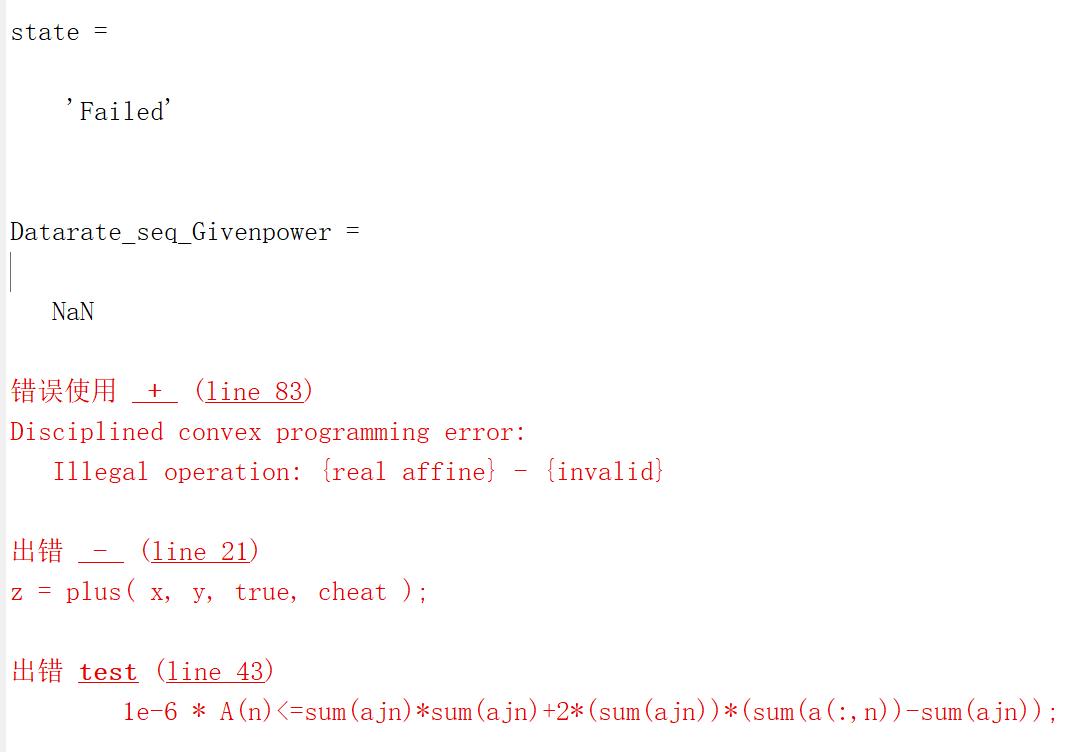N=128;
theta1=1e-3;
P_avg=1;
belta0=1e-3;
alpha=2.8;
S=[20,30,46,56,94,100,112,162,178,200;10,28,0,24,168,200,176,0,40,6];
H=50;
V_max=40;
T=20;
delta_t=T/N;
q0=[0;0];
qF=[200;200];
load(‘PerformanceComparison_Constrained_Main0206.mat’,‘qj_initial’,‘P_DatarateMax_Givenpath’,‘a_DatarateMax_Givenpath’)
MAX_ITR=2 ; %maximum iteration number
itr_cur=1;
eps=0.01;
Datarate_max=0;
optval_max=9;
old_optval=0;
new_optval=9;
qj=qj_initial;
Pj=Pj_initial;%Transmit power
aj=aj_initial;
Datarate_seq_Givenpower=[];
while itr_cur>=1
while (itr_cur>=MAX_ITR)||((abs(new_optval-old_optval))/optval_max<eps)
break;
end
old_optval=Datarate_max;
cvx_begin
cvx_solver sedumi
% cvx_quiet(true);
variable q(2,N+1); %the trajectory
variable A(1,N+1);
variable a(10,N+1);
maximize (sum(log(1+A./theta1))./(log(2)*N))
subject to
for n=1:N+1
ajn=aj(:,n);
1e-6 * A(n)<=sum(ajn)*sum(ajn)+2*(sum(ajn))*(sum(a(:,n))-sum(ajn));
end
for k=1:10
for n=1:N+1
qjn=qj(:,n);
1e-3 * a(k,n)<=1e-3 * sqrt(Pj(k,n)*belta0)*(((norms(qjn-S(:,k))).^2+H^2)^(-alpha/4)-alpha*((pow_pos(norms(q(:,n)-S(:,k)),2))-(norms(qjn-S(:,k))).^2)*(4*((norms(qjn-S(:,k))).^2+H^2)^(-alpha/4-1)));
end
end
for n=2:N+1
(pow_pos(norms(q(:,n)-q(:,n-1)),2))<=V_max^2*delta_t^2;
end
if ~isempty(q0)
q(:,1)==q0;
end
if ~isempty(qF)
qF==q(:,N+1);
end
cvx_end
Datarate_max=cvx_optval
new_optval=Datarate_max;
state = cvx_status
Datarate_seq_Givenpower =[Datarate_seq_Givenpower [Datarate_max]]
itr_cur=itr_cur+1;
qj=q;
aj=a;
end
q_conv_Givenpower=q;
A_conv_Givenpower=A;
a_conv_Givenpower=a;
